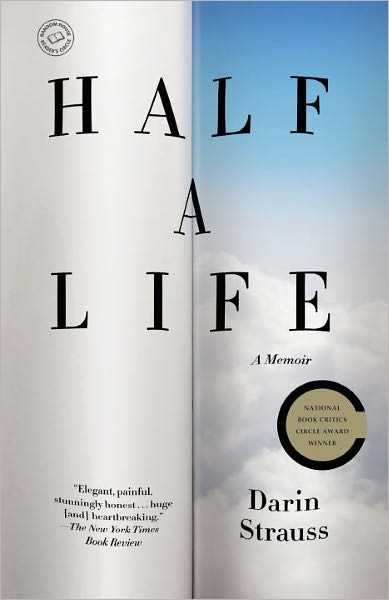Random House 2011
 It’s the punch of the first sentence in Darin Strauss’s memoir, Half a Life, which left me wide-eyed and eager to keep reading: “Half my life ago, I killed a girl.”
It’s the punch of the first sentence in Darin Strauss’s memoir, Half a Life, which left me wide-eyed and eager to keep reading: “Half my life ago, I killed a girl.”
At eighteen, Strauss was driving his father’s Oldsmobile when his high-school classmate, sixteen-year-old Celine Zilke, “made a crisp turn” on her bicycle, from the bike lane, into the four-lane road and head-on into Strauss’s vehicle. He wasn’t speeding or under the influence of alcohol or drugs. He could not have avoided the accident. Still, Strauss doesn’t let himself off the hook so easily, “pretend it’s alright that [he] felt even half okay.” He attends Celine’s funeral and promises her mother, at her behest, to live his life “twice as well” because he must live it for Celine, too.
As crude as this may sound, because of my own, nuanced experience with injury and death, Strauss’s tragic memoir was exactly what I’d been looking for. He helped me to better understand what it’s like for someone to live the rest of his life with the reality that he had played a role in the death of another human being.
In 2003, an eighty-six-year-old man mistook the gas pedal for the brake and sped in his Buick LeSabre through the Santa Monica Farmers’ Market, killing ten people and injuring dozens of others. With multiple injuries, I was just one of the eighteen critically injured pedestrians. Both Strauss’s horrific experience and mine were as random as a shooting star. We cannot control randomness.
The man who drove through the farmers’ market was a complete stranger to me. In an attempt to get to know him, I read the news articles and police reports and spoke at length with witnesses. I never had the opportunity to meet him since his family refused all of my attempts. It wasn’t until 2011, one year after his death, that I viewed the video recorded statement taken of the old man hours after the accident. Although he apologized in the video and said he tried everything possible to stop the vehicle, his inexplicable emotional unawareness made me angry. I was now left with the challenge of how to forgive an ostensibly myopic man who caused terrific harm to so many people. Where are we to turn when the so-called perpetrator is no longer available to answer our questions?
In contrast, through a poignantly human and barefaced account of the emotional shock that Strauss experienced during the immediate aftermath of the accident, and the denial and guilt, which consumed him in the ensuing days and years, he invites us into his “internal climate,” his “hurricane alley.” He trusts us with what he calls his “pubescently egocentric” thoughts: “How would people see me? How seriously will I be messed up by this?”
However, during his eighteen-year journey mired in grief, starting from the day of the accident and ending with the earlier years of his marriage and fatherhood, Strauss transcends his state of denial and his self-centered responses to the accident. He comes to a place of recognition; the irrevocable nature of the accident, and the emotional trauma he must endure, is no longer just his to face alone. It becomes an integral part of his relationships with his wife and children. Along with his awareness of his “immature, offensive thoughts,” Strauss’s lack of embellishment—he does not over-dramatize the civil suit the Zilke family files against him, for instance—leaves space for us to empathize.
So, if you can bear the emotional interiority of someone who took part in the death of another, Half a Life is the place to do just that. Strauss says, “Things don’t go away. They become you.” Yet, he convinced me that even if we miss out on the opportunity to understand those who’ve hurt us, resolution is possible.
—
Melissa Cronin holds an MFA in creative nonfiction from Vermont College of Fine Arts. She is currently working as a freelance writer and writing a memoir about the 2003 Santa Monica Farmers’ Market accident. A nurse and Irish fiddler, she lives in South Burlington, Vermont, with her husband, John.
